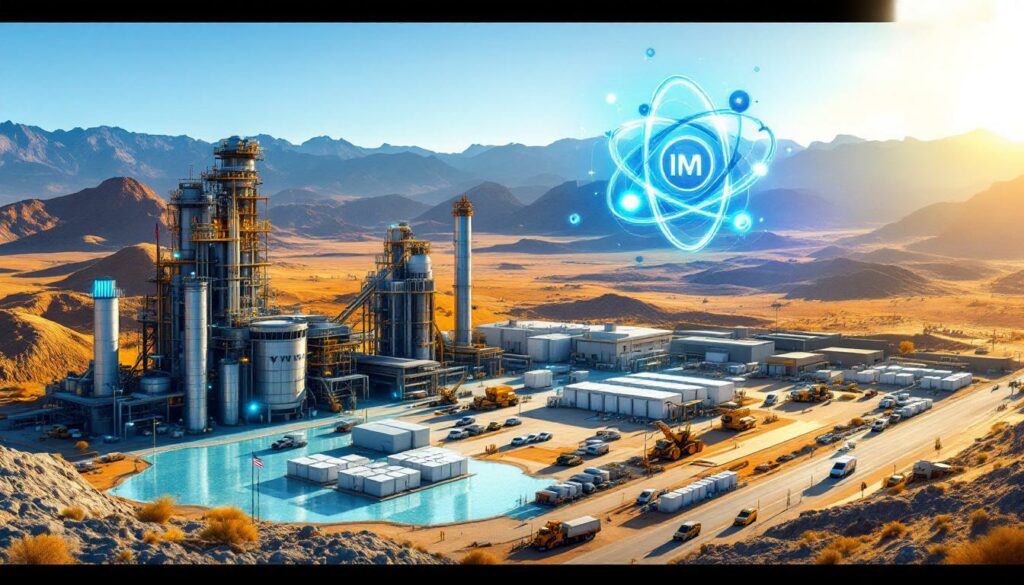What is the $900 Million EXIM Letter of Interest for ABTC's Nevada Project?
American Battery Technology Company (ABTC) has secured a landmark $900 million Letter of Interest (LOI) from the Export-Import Bank of the United States (EXIM Bank) for its Nevada Lithium Project. This preliminary financial backing represents a significant vote of confidence in domestic critical minerals production and marks a pivotal moment for America's battery supply chain independence.
The LOI, announced in June 2025, directly supports ABTC's integrated lithium mining and processing facility near Tonopah, Nevada. This development comes in direct response to recent executive orders aimed at accelerating American mineral independence, particularly President Trump's Trump mining order directive.
"This proposed financial support can greatly accelerate the commercialization of our domestic critical mineral mine and refinery," stated ABTC CEO Ryan Melsert. "We are excited to implement at scale these first-of-kind technologies that we have been demonstrating over the past several years."
While the LOI represents a preliminary expression of interest rather than a binding financial commitment, it signals strong federal backing for a project that could transform America's position in the global battery materials market. The potential financing would primarily support construction of both mining operations and ABTC's innovative claystone-to-lithium hydroxide refining facility.
Note: A Letter of Interest from EXIM Bank indicates preliminary support subject to further due diligence and final approval processes. It represents a significant step toward potential financing but does not constitute a loan guarantee.
How Does the Nevada Lithium Project Support Domestic Battery Supply Chains?
Project Scale and Production Capacity
The Nevada Lithium Project represents a transformative force for America's battery supply chain resilience. With projected annual production of approximately 33,000 tons of battery-grade lithium hydroxide, the facility could supply enough material to manufacture batteries for roughly 500,000 electric vehicles annually.
Located near Tonopah, Nevada, the project offers several strategic advantages:
- Massive resource base: Confirmed through rigorous SEC-compliant assessments as one of the largest known lithium resources in the United States
- Integrated operations: Combined mine and refinery design significantly reduces transportation costs and carbon emissions
- Logistical efficiency: Strategic position with rail access for efficient distribution to U.S. battery manufacturers
- Domestic supply: Potential to reduce America's 80% dependence on foreign lithium imports, particularly from China
The scale of ABTC's operation places it on par with major global lithium producers while offering distinct advantages through its domestic location and integrated approach. By establishing this production capacity within U.S. borders, ABTC addresses a critical vulnerability in America's energy transition strategy.
Economic and Technical Assessment
In April 2024, ABTC released an amended Initial Assessment following strict SEC guidelines that validated both the technical feasibility and economic viability of the Nevada project. This comprehensive evaluation confirmed several critical factors:
- Resource validation: Detailed geological assessment confirming substantial lithium reserves
- Technical feasibility: Verification of ABTC's proprietary extraction and processing technologies
- Economic viability: Positive financial projections despite capital-intensive development requirements
- Strategic significance: Qualification as a project of national importance for mineral independence
The assessment's rigorous methodology provides investors, partners, and government stakeholders with confidence in ABTC's ability to deliver on its ambitious production goals. By adhering to SEC reporting standards, the company has established a solid foundation for advancing this critical minerals strategy.
Why is EXIM Bank Backing This Critical Minerals Project?
Alignment with Federal Priorities
The $900 million EXIM Bank LOI for ABTC's Nevada Lithium Project represents a direct implementation of federal strategic priorities for critical minerals. This support aligns perfectly with President Trump's executive order "Immediate Measures to Increase American Mineral Production," which specifically calls for expediting domestic lithium development.
This backing reflects several key federal objectives:
- National security enhancement: Reducing dependence on potentially unreliable foreign lithium sources
- Supply chain resilience: Creating redundancy in critical mineral procurement channels
- Industrial policy advancement: Rebuilding America's manufacturing capabilities in strategic sectors
- Technological leadership: Maintaining U.S. competitive advantage in next-generation energy technologies
The EXIM Bank's involvement demonstrates a whole-of-government approach to critical minerals, engaging financial institutions alongside regulatory agencies to accelerate development timelines. This coordinated strategy represents a significant evolution in how the federal government approaches resource development.
Financial Support Structure
The $900 million Letter of Interest provides a framework for potential EXIM Bank financing, though several steps remain before funds would be disbursed. This preliminary commitment outlines:
- Construction focus: Funding primarily targeted toward building both mining and refining infrastructure
- Commercial acceleration: Financial support designed to reduce time-to-market for domestic lithium
- Due diligence pathway: Clear milestones for progressing from LOI to binding financial agreements
- Precedent setting: Potential model for similar critical mineral projects seeking federal backing
This financing approach represents a shift in how America supports strategic resource development, moving beyond regulatory streamlining to direct US EXIM funding. If finalized, the EXIM support would substantially reduce ABTC's capital raising challenges while establishing a template for financing similar projects nationwide.
Important context: Unlike direct subsidies or grants, EXIM Bank financing must be repaid with interest, ensuring taxpayer protection while still providing crucial support for strategic industries.
How Will ABTC Implement This Large-Scale Lithium Project?
Engineering and Development Partners
ABTC has formed a strategic partnership with Black & Veatch, a globally recognized engineering and construction firm with extensive experience in complex industrial facilities. This collaboration brings world-class implementation expertise to ABTC's innovative technology platform.
The implementation strategy leverages several complementary strengths:
- Design expertise: Black & Veatch's engineering capabilities applied to ABTC's proprietary processes
- Technology readiness: Scale-up of processes already demonstrated at pilot scale over several years
- Construction management: Professional oversight ensuring on-time, on-budget delivery
- Risk mitigation: Systematic approach to addressing first-of-kind technology challenges
This partnership model combines ABTC's technological innovation with Black & Veatch's established track record in delivering large-scale industrial projects. By bringing together these complementary capabilities, ABTC positions itself to overcome the typical challenges associated with scaling novel mineral processing technologies.
Innovative Processing Approach
At the heart of ABTC's Nevada project lies a revolutionary claystone-to-lithium hydroxide refining methodology that offers significant advantages over traditional lithium extraction techniques. This approach features:
- Resource efficiency: Lower water consumption than traditional brine operations
- Dual capabilities: Integration of primary extraction with secondary lithium-ion battery recycling
- Environmental optimization: Reduced carbon footprint compared to conventional methods
- Process integration: Seamless flow from mining through refining to battery-grade material
The company's processing innovations represent a potential paradigm shift in lithium production, moving beyond the limitations of traditional brine evaporation or hard-rock mining. By developing methods specifically optimized for Nevada's unique claystone deposits, ABTC has created intellectual property that could provide lasting competitive advantages.
"We are excited to implement at scale these first-of-kind technologies that we have been demonstrating over the past several years," explains CEO Ryan Melsert, highlighting the company's confidence in its technical approach.
What Makes This Project Significant for U.S. Battery Manufacturing?
Strategic Importance to Domestic Supply Chain
ABTC's Nevada Lithium Project addresses a critical vulnerability in America's transition to electric vehicles and renewable energy storage. By establishing significant domestic lithium production capacity, the project:
- Reduces import dependence: Could cut U.S. lithium imports by approximately 15% by 2030
- Enhances security: Creates resilience against supply disruptions from international conflicts or trade disputes
- Supports manufacturing: Provides reliable material inputs for U.S. battery gigafactories
- Creates employment: Expected to generate over 300 high-skilled permanent jobs in rural Nevada
The strategic significance extends beyond the immediate economic benefits. As lithium demand for EVs and grid storage continues its exponential growth, domestic production becomes increasingly vital to national energy security objectives. The Nevada project represents a cornerstone in building this self-sufficient capability.
Technological Innovation
Beyond its production capacity, ABTC's Nevada project advances American leadership in sustainable mining innovation trends. Key innovations include:
- Novel extraction methods: Proprietary techniques optimized for Nevada's unique claystone geology
- Integrated operations: Seamless mine-to-battery material production reducing logistical complexity
- Environmental advantages: Lower water usage and carbon emissions compared to conventional methods
- Technology transfer potential: Techniques applicable to other critical mineral deposits nationwide
These technological advances position the U.S. to compete globally not just in lithium production volume, but in the sustainability and efficiency of mineral extraction methods. The development of these capabilities represents intellectual capital that extends beyond a single project to enhance America's mineral independence broadly.
Environmental perspective: While all mining operations have environmental impacts, ABTC's innovations in water-efficient processing and integrated refining could establish new sustainability benchmarks for the lithium industry.
What Are the Next Steps for ABTC's Nevada Project?
From LOI to Project Implementation
ABTC faces a structured pathway from the current EXIM Bank Letter of Interest to full project implementation. This process includes:
- Financial finalization: Converting the $900 million LOI into binding loan agreements through EXIM Bank's due diligence process
- Engineering advancement: Completing detailed engineering designs with Black & Veatch
- Permitting progress: Navigating federal and state approval processes, likely expedited under critical minerals provisions
- Construction planning: Developing detailed execution plans for both mining and refining facilities
The company must balance maintaining momentum with ensuring proper regulatory compliance and engineering thoroughness. With federal backing signaling national priority status, ABTC may benefit from streamlined permitting under FAST-41 and other expedited review processes established for critical infrastructure.
Industry analysts anticipate final financing agreements could be completed by Q4 2025, potentially allowing construction to begin in early 2026, though ABTC has not confirmed these specific timeline targets.
Commercial Production Timeline
While ABTC has not publicly released a detailed production schedule, industry experts project the following likely timeline based on similar projects:
- Construction initiation: Likely 2026 (pending financing and permitting)
- Mine development: 12-18 months from groundbreaking
- Refinery construction: 24-30 months for process plant completion
- Commissioning: Phased approach beginning with mining operations
- Full production: Ramp-up to 33,000 ton capacity over approximately 24 months
The company appears focused on accelerating this timeline through its partnership with Black & Veatch and the potential EXIM Bank financing. Long-term production could potentially increase beyond initial targets through resource expansion and processing optimization, though such growth would require additional capital investment and regulatory approvals.
Integration with downstream battery manufacturers remains a critical strategic question, with potential partnerships under discussion but not yet publicly disclosed.
FAQ: ABTC's Nevada Lithium Project
What exactly is a Letter of Interest (LOI) from EXIM Bank?
An LOI from the Export-Import Bank represents preliminary interest in providing financing but does not constitute a binding commitment. It signals federal support for the project and establishes a framework for potential future financing arrangements pending further due diligence and approvals.
EXIM Bank LOIs typically indicate projects align with national priorities and have passed initial screening. However, several steps remain before financing is secured, including comprehensive technical, financial, and environmental reviews. The $900 million figure represents a maximum potential financing amount rather than a guaranteed loan.
How does claystone lithium extraction differ from traditional methods?
Claystone lithium extraction processes lithium from clay deposits rather than the more common brine or hard rock sources. This approach offers several distinct differences:
- Resource characteristics: Claystone deposits contain lithium adsorbed onto clay particles rather than dissolved in brines or bound in hard rock minerals
- Processing requirements: Typically involves acid leaching rather than evaporation or crushing/grinding
- Water efficiency: Generally uses less water than brine operations but more than hard rock mining
- Extraction timeline: Faster than brine evaporation but requires more complex processing
ABTC's proprietary approach reportedly optimizes this process specifically for Nevada's unique geological conditions. While claystone extraction remains less common globally than brine or hard rock methods, it offers compelling advantages for certain deposit types and geographical settings.
What impact might this project have on U.S. lithium prices?
Domestic production at this scale could potentially help stabilize U.S. lithium prices by reducing dependence on imports and shortening supply chains. However, lithium remains a globally traded commodity, so pricing will continue to be influenced by international market dynamics alongside domestic supply increases.
Key factors influencing the price impact include:
- Transportation savings: Reduced logistics costs for domestic battery manufacturers
- Supply reliability: Premium value for secure, consistent supply
- Global context: Continued influence of major producers in Australia, Chile, and China
- Demand growth: Rapidly expanding EV and energy storage markets potentially outpacing supply
While 33,000 tons represents significant production, it remains a fraction of projected global demand, suggesting the project will contribute to price stability rather than causing dramatic price reductions.
How does this project compare to other U.S. lithium developments?
This project represents one of the largest potential lithium resources in the United States, with its integrated mine-to-refinery approach distinguishing it from many other developments that focus on either mining or processing, but not both in a single operation.
Comparative distinctions include:
- Scale: Larger than Silver Peak (Nevada's only current lithium production at ~5,000 tons annually)
- Integration level: More vertically integrated than most competitors who focus on either mining or refining
- Technology approach: Novel claystone processing versus more traditional methods
- Financing structure: Unique federal backing through EXIM Bank versus primarily private financing
While several other major lithium projects are advancing in states including Nevada, North Carolina, and Arkansas, ABTC's combination of scale, federal backing, and integrated design creates a distinctive profile in the emerging U.S. lithium landscape.
Further Exploration:
Readers interested in learning more about developments in domestic battery materials production can also explore related educational content available through AInvest's analysis of the loan's impact and understand battery metals investment trends that are reshaping the industry.
Want to Discover the Next Major ASX Mining Opportunity?
Discover the next significant mineral find before the market with Discovery Alert's proprietary Discovery IQ model, delivering real-time notifications on ASX announcements with potential for substantial returns. Explore our dedicated discoveries page to understand how early investors capitalised on historic finds like De Grey Mining and WA1 Resources.




